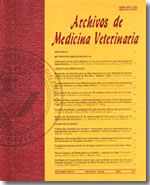Detection of glycosaminoglycans of the articular cartilage matrix in the synovial fluid of equine carpal joint with chip fracture
Main Article Content
Abstract
The purpose of this study was to establish if the duration of chip fracture in equine carpal joint of purebred horses, affects the synovial concentration of total glycosaminoglycans (GAGsT) and glycosaminoglycans that are different from hyaluronic acid or sulfated GAGs (GAGsS). Two groups of horses with different duration of fracture period were analyzed: one group (group I) with a period of less than 30 days from carpal fracture diagnosis to arthrocentesis (n=14), and another group (group II) with a period similar or longer than 60 days (n=14). Normal synovial fluid was collected from healthy carpal joints of crossbred horses immediately after slaughter (n=14), without any major damage at post mortem examination. The synovial fluid concentration of protein and GAGs was determined spectrophotometrically. Protein concentration showed a significant increase (P < 0.05) in both fracture samples (18.19 ± 4.2 g/L (group I) and 18.28 ± 3.5 g/L (group II)) with respect to the control group (9.05 ± 5.1 g/L). GAGsT concentration significantly increased (P < 0.05) in the control group (1.5 ± 0.52 g/L) with respect to both fracture groups (1.07 ± 0.29 g/L (group I) and 1.17 ± 0.35 g/L (group II)). The synovial fluid GAGsS showed no significant difference (P>0.05) between control group (0.19 ± 0.12 g/L) and both fracture groups (0.15 ± 0.09 g/L (group I) and 0.17 ± 0.17 g/L (group II)). The concentration of hyaluronic acid, obtained by the difference between GAGsT and GAGsS, showed a significant increase (P < 0.05) in the control group (1.31 ± 0.51 g/L) with respect to both fracture groups (0.92 ± 0.30 g/L (group I) and 0.90 ± 0.40 g/L (group II)). The absence of significant differences for GAGsT, GAGsS and hyaluronic acid concentrations between both fracture groups, could be related to the dilution effect caused by the inflammation, the appearance of compensatory mechanisms, or restrictions due to the use of an in vivo articular model.

